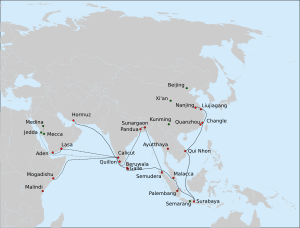Hong Bao facts for kids
Hong Bao (Chinese: 洪保) was an important Chinese official who lived from about 1412 to 1433. He was sent on many trips to other countries to represent China during the time of the Yongle Emperor and Xuande Emperor in the Ming dynasty. He is most famous for leading a smaller group of ships within Zheng He's large fleet during its seventh big journey to the Indian Ocean (1431–1433).
Contents
Early Journeys and Missions
An old Chinese history book, the History of Ming, tells us that in 1412, Emperor Yongle sent Hong Bao as a special representative to Thailand. This happened between Zheng He's third and fourth big voyages.
In 1421, Hong Bao joined Zheng He's sixth voyage. On this trip, they took foreign representatives back to their homes, traveling as far as a place called Ormus.
Hong Bao's Role in the Seventh Voyage
Hong Bao's name is carved on a stone tablet that Zheng He made in Liujiagang in 1431. This was just before Zheng He's fleet left China for its seventh and final journey to the "Western Ocean" (which is the Indian Ocean).
The carving says that the two main leaders chosen by the Xuande Emperor for this journey were the officials Zheng He and Wang Jinghong. Hong Bao was one of the five assistant leaders. All the main and assistant leaders, except for one, had the high official rank of Grand Director (太監, Taijian).
Much of what we know about Hong Bao comes from a book written by an interpreter named Ma Huan. Ma Huan worked in Hong Bao's group of ships during this seventh voyage.
According to experts who have studied the records of the voyage, Hong Bao's group of ships likely separated from the main fleet in Semudera, a place in northern Sumatra. His group then traveled to Bengal. From Bengal, Hong Bao's ships would have gone to Calicut in southern India. The main fleet went directly to Calicut from Semudera, crossing the Bay of Bengal.
While the main fleet left Calicut to go to Ormus (in the Persian Gulf), Hong Bao's group traveled from Calicut to different places on the western side of the Arabian Sea. These places included Aden in southern Arabia and Mogadishu in the Horn of Africa. Before leaving Calicut, Hong Bao sent seven of his sailors, including Ma Huan, to Mecca and Medina. They traveled on a local ship that was going to Jeddah.
Hong Bao's Burial Place
In June 2010, a leader from the Archaeology Department at Nanjing Museum announced an exciting discovery. A grave from the Ming Dynasty was found near Zutang Mountain in the Jiangning District of Nanjing. It was identified as the grave of Hong Bao. At first, some thought it might be Zheng He's grave, but later it was confirmed to be Hong Bao's.
Hong Bao in Books
In his book 1421: The Year China Discovered the World, an amateur historian named Gavin Menzies made some big claims. He suggested that Hong Bao traveled to faraway places like Antarctica and Australia.


